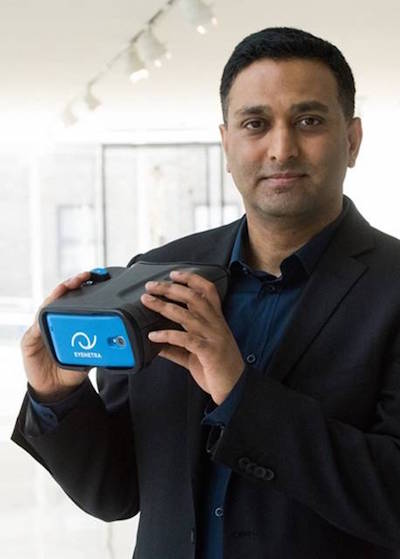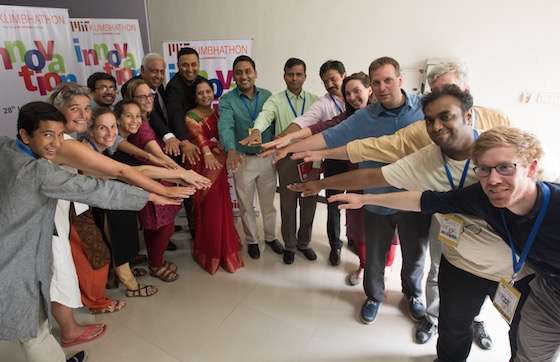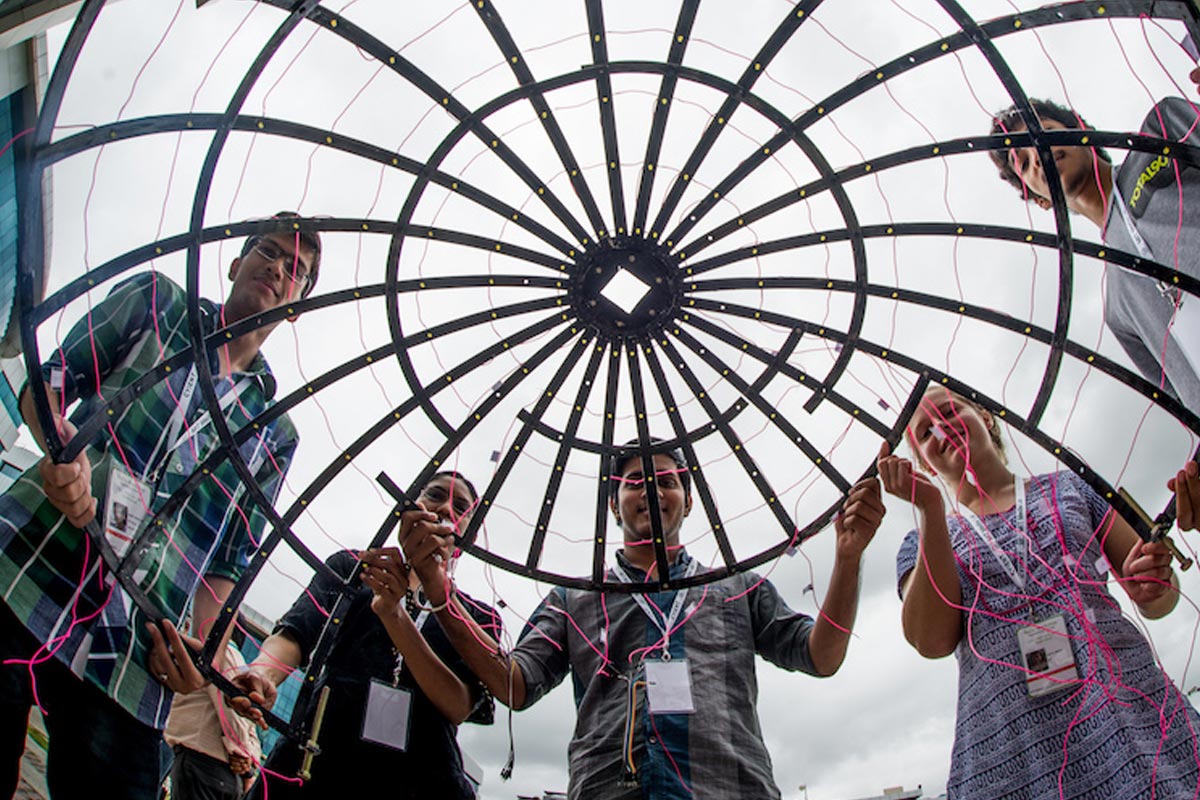In September 2016, Dr. Ramesh Raskar, an associate professor at the MIT Media Lab and holder of more than 75 patents, was awarded the $500,000 Lemelson-MIT Prize for his work in developing radical imaging solutions.
The Wall Street Journal called Raskar’s inventions “trailblazing,” citing a growing resume that includes the co-invention of an ultra-fast imaging camera that can see around corners, low-cost eye-care solutions, and a camera that lets users read the first few pages of a book without opening the cover. Dorothy Lemelson said: “Ramesh’s femto-photography work not only has the potential to transform industries from internal medicine to transportation safety, it is also helping to inspire a new generation of inventors to tackle the biggest problems of our time.”
 Raskar, 46, is the 22nd recipient of the annual prize, which recognizes outstanding mid-career inventors who are improving the world through technological invention and demonstrating a commitment to mentorship in science, technology, engineering, and mathematics (STEM). Past prizewinners include Douglas Engelbart, inventor of the computer mouse; biologist Leroy Hood; and Nick Holonyak, inventor of the light-emitting diode, or LED.
Raskar, 46, is the 22nd recipient of the annual prize, which recognizes outstanding mid-career inventors who are improving the world through technological invention and demonstrating a commitment to mentorship in science, technology, engineering, and mathematics (STEM). Past prizewinners include Douglas Engelbart, inventor of the computer mouse; biologist Leroy Hood; and Nick Holonyak, inventor of the light-emitting diode, or LED.
We caught up with Dr. Raskar for a conversation about his research, his passions, and his take on the future of invention education.
LEMELSON FOUNDATION: You were born and raised in India. What was your childhood like, and who were your early influences?
RAMESH RASKAR: My father served in the Army and came from an extremely modest background. He didn’t make a lot of money in his career. But after he took an early retirement from military service, he dedicated himself in a focused way to the education of his children, and to helping others. After the army, he spent almost six years working in a hospital, assisting patients and doctors, leading offsite camps for children, and helping poor people navigate their financial conditions. He set an example of what it means to work hard and to help others.
LEMELSON: When did you realize that you were on a path to becoming an inventor?
RASKAR: I am the youngest of four children, and I had a lot of support from my father and my older siblings. My family members did not get the same educational opportunities and support that I was lucky enough to receive. But because I scored so highly on my exams from an early age, I found myself on a certain path, and certain doors were opened to me based on my academic abilities. I didn’t realize until a bit later that I was interested in the connection between invention and social impact, however. But a lot of it came from my family, the support they provided, and the example our father set.
LEMELSON: The work that led to your selection for the Lemelson-MIT prize involves complex imaging technology. How do you explain femto-photography to a lay person?
RASKAR: The simplest analogy is probably sound. Most people can conceptualize how sound waves travel – like echoes of sound. They move relatively slowly, and its not difficult to understand how they disperse and flow around a room, or even around a corner. Light is similar, except it travels so much faster that we cannot process or sense the echoes of light in the same way we do sound. But just as sound moves around corners, with femto-photography we are able to use echoes of light to see around corners or through things. The camera is so fast that you can create slow motion videos of light in motion – and with that we can create cameras that can look around corners or beyond line of sight.
LEMELSON: Your research represents a significant breakthrough for imaging. What important problems can femto-photography help solve? What is the practical application for seeing around corners or looking through book covers?
RASKAR: The implications and applications are almost limitless. If you start by thinking about it in relation to things that we already understand today, you can imagine how it could help a self-driving car see around the bend to know what’s coming. Or how it could help with looking for survivors in hazardous conditions like after an earthquake. When x-ray technology was invented, it allowed us for the first time to see inside the body. And we eventually came to to realize that it was useful for all types of diagnostic purposes. It helped us understand the body in a whole new way. So, too, with femto-phography. Every time you can see the world in a new way it opens up new doors for understanding.
LEMELSON: What does it take to become a good inventor? What skills or qualities are most critical for success?
RASKAR: Truthfully, my thinking on that question has changed. Ten or 15 years ago, I probably would have said it was about being clever. But now I realize that cleverness alone is not enough. The challenges we are facing in our world today are incredibly complex. And so, at some level, the inventor’s job requires you to think in an anti-disciplinary manner – not multi-disciplinary or across fields, but in a way that looks beyond disciplines. Take my own work with imaging and machine learning as an example. When we identified the question of how we might see around corners, I realized that the solution is not at the intersection of those two fields. It is actually outside of both of them.
LEMELSON: So does that suggest that specialization is not necessary?
RASKAR: I have been fortunate to learn with and from some brilliant mentors, and through them I realized that I don’t have to know everything there is to know within a given field. I don’t know as much about biology or photography or software as many others do. But it doesn’t matter. Today’s world is more like the Silk Road. We (inventors) are traders of ideas who need to look at what’s passing on the Silk Road and, based on what we are exposed to, decide what to do next. You start to see that the true power of an inventor is less about expertise on one subject, but rather the ability to ask questions no one else is asking and follow the trail of answers as they are revealed.
The true power of an inventor is less about expertise on one subject, but rather the ability to ask questions no one else is asking and follow the trail of answers as they are revealed.
LEMELSON: Speaking of asking questions, you speak often about a process you call “spot-probe.” What does that mean?
RASKAR: In my opinion the “spot probe” methodology is something every inventor needs to master. There is a great deal of value in asking challenging questions and spotting problems, but that alone is not usually enough. There is also a need for probing those problems. So it is a continual cycle: Ask a lot of questions. Spot a lot of problems. Articulate those problems. Then probe their potential solutions. For example, when I was trying to invent a camera that could see around corners, no one was coming to me and asking me to solve that particular problem. But my “spot probe” process led me to identify dozens of problems, and that was one where I knew I could probe for solutions…and that’s what led to a breakthrough.
LEMELSON: There are countless ways you could have chosen to direct your talents. What inspired you to work on radical imaging solutions?
RASKAR: From a young age I was fascinated with visual imagery, like a lot of people are. I also had this consistent feeling that there was nothing behind me, that the world I saw it existed only in front of me. That’s sort of what virtual reality is. You only see what is in front of you, and as you turn your head, the world gets painted or comes into view just in time. So I began to think of the world, of my reality, as a series of images or a sequence of pictures. There was nothing I could do with this feeling until a bit later in my life. Eventually, for my PhD thesis I developed a prototype of the first true 3-D videoconferencing system, where moving around the display changed the perspective on what was depicted.
 LEMELSON: You are planning to invest a portion of the Lemelson-MIT Prize money in supporting young and emerging inventors. What will that entail?
LEMELSON: You are planning to invest a portion of the Lemelson-MIT Prize money in supporting young and emerging inventors. What will that entail?
RASKAR: REDX is a project we’ve launched that stands for “rethinking design engineering execution.” It brings together technical experts, innovators, research institutions, implementation partners and corporate partners to solve the most pressing challenges in our communities. The philosophy behind it says that in order to solve real problems in the world we have to help young people learn the framework for problem solving. So we put innovators through a ten-week program, and allow them to do “spot probe” exercises in a very methodical manner to build those essential skills. It runs online and off – sort of like a club that meets once a week. We are targeting college kids and high school students from across the globe. We have clubs now in almost every continent.
LEMELSON: There are a lot of inventors in the world creating products that make our lives more convenient, but have minimal impact on the bigger “problems worth solving.”
RASKAR: Solving big societal problems requires both passion and skill, but those qualities exist on two different axes. A lot of folks have passion but don’t think about that as a way to make a living. Others have technical skills but don’t know how to connect them to their passions. I see a lot of MIT students go to Africa to help build houses or repair computers, which is great. But that type of service isn’t necessarily where breakthrough change happens. It builds empathy, of course, but how scalable is it? And are they fulfilling their potential to do the most good or create the most change? The hardest problems to work on are found where those two axes intersect – where passion meets skill.
This next generation of young students is going to spot a whole new set of problems and probe for solutions that no one can begin to predict.
LEMELSON: How can inventors ensure that what they are working on will make a difference in the grand scheme?
RASKAR: Sometimes the problem you might be inclined to solve is not the right problem at all. For example, right now I am thinking about how our world might be better if everyone had a street address. It’s not widely known, particularly in the West, but 80 percent of the world’s roads actually have no street name – which can be a huge problem for everything from health care delivery to disaster management to e-commerce. So if people are dying in Kenya because ambulances can’t get to emergencies quickly enough, the best solution might not be 100 more ambulances. It might be a universal address system that makes it easier for everyone to navigate. If it is a systemic problem, it probably requires a systemic solution.
LEMELSON: To the casual observer, invention can seem like a “bolt of lightning” striking unpredictably. But in truth being a good inventor requires discipline and persistence. Are there any methods or strategies you think can help accelerate success for an inventor?
RASKAR: I like my students to work on thee or four projects in a year on a rotation. That exposes them to a lot of different skills and diverse work styles. At the end of the day, invention is all about people. If you don’t work with the right people you don’t get inspired to work in the right way. I believe we learn much faster from others than we do from books. There are also differences between problem solving and invention. If all you are doing is problem solving, you can work in isolation. But to invent you need give and take. The spark comes most often through the dynamic of being engaged with others.
LEMELSON: How do you see your imaging work evolving and expanding? And what changes will it bring about in the world?
RASKAR: Every time we can see the world in a new or different way, great things happen. Think about the first time we were able to call across the Atlantic, or see inside the body. Then consider what followed and what was built on those breakthroughs. In today’s world it’s not uncommon for the invention process to move from idea to dissemination in 10 years or less. The pace of change is really rapid. Many others have caught on to the idea of femto-photography and there are dozens of teams around the world working on it. That’s where the big breakthroughs will come.
LEMELSON: And what will you be doing 20 years from now?
RASKAR: My passion is to inspire a new generation of young people to solve the right problems at the right time. I want my work to play some small role in helping young people come up with solutions that we can’t even imagine yet. Right now the world may be focused on tackling what we see as the mega problems of our day – things like malnutrition or climate change. But this next generation of young students is going to spot a whole new set of problems and probe for solutions that no one can begin to predict.

